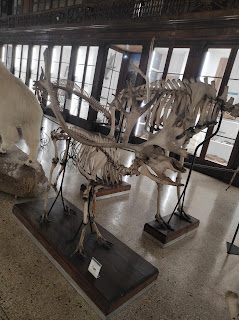Reindeer and caribou: deer of extremes
 |
| The male reindeer (or so it is labelled) specimen at the Zoological Museum of Naples. I'm not sure to what species/subspecies/ecotype it belongs to, or if it is indeed a reindeer and not a caribou. |
Reindeer and caribou are deer of extremes: they evolved in Ice Age environments and have a circumpolar distribution, encompassing quite a wide variety of ecotypes and forms, including barren ground, woodland, mountain, and even insular forms (Geist 1999; Holand et al. 2022). Incidentally, while traditionally all placed in one taxon, Rangifer tarandus, with a number of subspecies, some authors have erected them to full species level (Harding 2022).
As for common names, "reindeer" usually refers to members of Rangifer from Eurasia, "caribou" to those of North America (Geist 1999; Harding 2022).
Some of these forms are sedentary, while others, particularly barren ground forms, are migratory, and they hold the record of (probable) longest terrestrial migration (> 1200 km; Geist 1999; Joly et al. 2019; Holand et al. 2022). Indeed, reindeer and caribou are the most cursorial of modern deer, although the extinct giant deer (Megaloceros giganteus) was even more extreme in its cursorial adaptations (Geist 1999).
 |
| Another view of the same specimen, highlighting the short-legged cursorial body proportions. |
 |
| Yet another angle of the same specimen, showing the asymmetrical antlers. |
Reindeer and caribou are also the only deer species in which females regularly develop antlers, and it's been suggested they may use them to compete with males for food resources during winter (they shed them later than males; Geist 1999; Heckeberg et al. 2022; Holand et al. 2022).
You can see from the photos that reindeer and caribou are also peculiar in their lower limbs: Rangifer belongs to the Capreolinae or New World deer, also known as telemetacarpalian deer, a name that describes a condition in which the reduced second and fifth metacarpals are in a distal position, while they are in a proximal position (the plesiometacarpalian condition) in Cervinae or Old World deer (Geist 1999; Heckeberg 2020).
 |
| A selection of other members of Capreolinae, also displayed at the Zoological Museum of Naples. Clockwise from top left: marsh deer (Blastocerus dichotomus), Siberian roe deer (Capreolus pygargus), and European roe deer (Capreolus capreolus). The moose is also a member of the group. |
Finally, reindeer (but not caribou) are the only deer to have been semi-domesticated on a large scale, and they have a long history of great importance among Arctic peoples for subsistence and other uses, as testified by archeological remains and even cave paintings from the Last Glacial Maximum (Geist 1999; Holand et al. 2022).
References
- Geist, V. (1999). Deer of the World. Swan Hill Press, Shrewsbury.
- Goss, R. J. 1990. Interactions between asymmetric brow tines in caribou and reindeer antlers. Canadian Journal of Zoology 68:1115–1119.
- Harding L. E. (2022) Available names for Rangifer (Mammalia, Artiodactyla, Cervidae) species and subspecies. ZooKeys 1119: 117–151. https://doi.org/10.3897/zookeys.1119.80233
- Heckeberg, N. S. (2020). The systematics of the Cervidae: A total evidence approach. PeerJ, 8, e8114.
- Heckeberg N. S., Zachos F. E., Kierdorf U. Antler tine homologies and cervid systematics: A review of past and present controversies with special emphasis on Elaphurus davidianus. The Anatomical Record. 2023;306(1):5-28. DOI: 10.1002/ar.24956
- Holand, Ø., Mizin, I., Weladji, R.B. (2022). Reindeer Rangifer tarandus (Linnaeus, 1758). In: Corlatti, L., Zachos, F.E. (eds) Terrestrial Cetartiodactyla. Handbook of the Mammals of Europe. Springer, Cham. https://doi.org/10.1007/978-3-030-24475-0_24
- Joly, K., Gurarie, E., Sorum, M.S. et al. Longest terrestrial migrations and movements around the world. Sci Rep 9, 15333 (2019). https://doi.org/10.1038/s41598-019-51884-5
- Mäkinen, A. (2022). “The effect of the nasal anatomy on the behaviour patterns of the European elk (Alces alces)” (Thesis).
- Petronio, C., Di Canzio, E., Salari, L., 2007. The Late Pleistocene and Holocene Mammals in Italy: new biochronological and paleoenvironmental data. Palaeontographica Abteilung A 279, 147–157. https://doi.org/10.1127/pala/279/2007/147.




Comments
Post a Comment